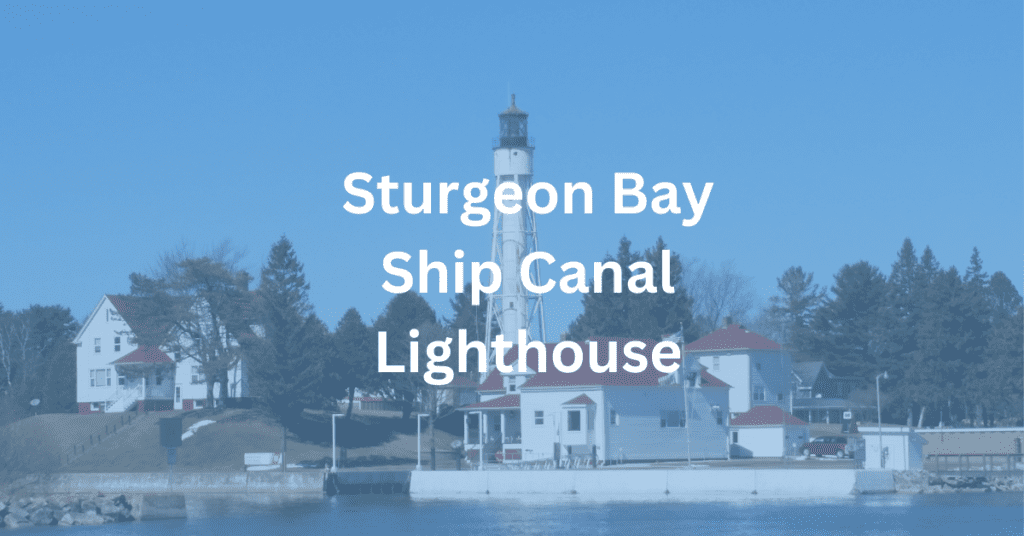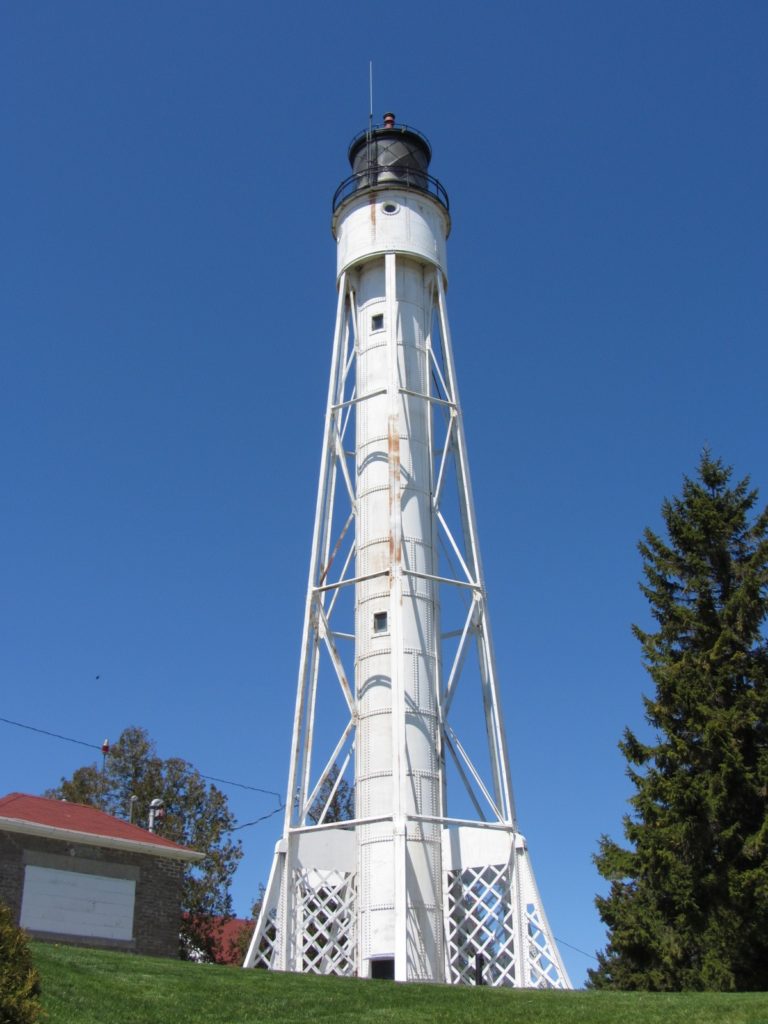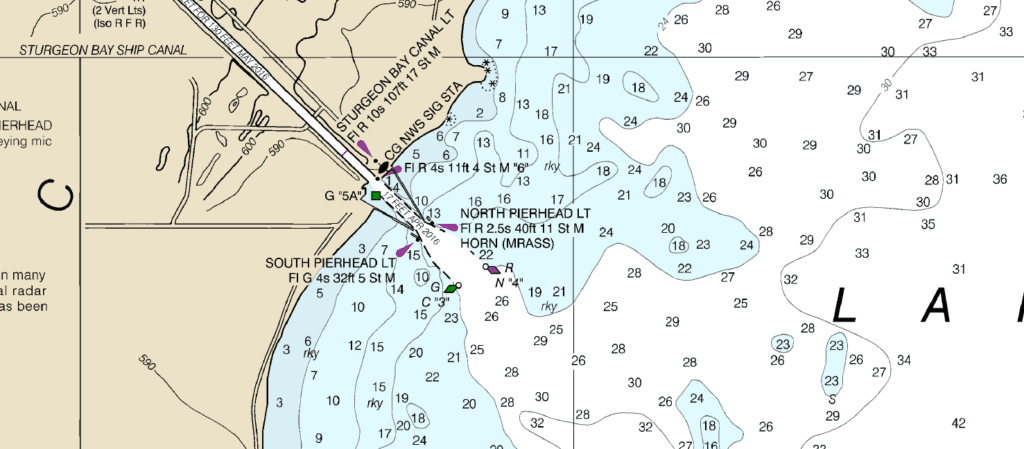I love the contrast between the Sturgeon Bay Ship Canal Lighthouse and the nearby Pierhead Lighthouse. The white lighthouse with its elegant braces soars into the air, while the stalwart Pierhead Lighthouse stands guard at the mouth of the Ship Canal.
The Sturgeon Bay Ship Canal Lighthouse is worth a visit. Even though you can’t tour the interior, it’s a beautiful sight to see with a rich history. This post will help you make the most of a visit to the lighthouse by telling you how to get there and also by giving you facts about it and its history that will enrich your knowledge of this iconic structure. Here is what we are going to cover in this post:
- Quick Facts
- How to visit the Sturgeon Bay Ship Canal Lighthouse
- The History of the Sturgeon Bay Ship Canal Lighthouse
- Frequently Asked Questions
- Summary
If you’re interested in lighthouses, Door County is one of the best places to visit. Make sure to check out our comprehensive post about Door County’s 11 lighthouses to learn more about these iconic structures.

Quick Facts
- Easy to view on either side of the ship canal
- Interior is not open to the public
- Originally built in 1898
- Steel braces added in 1903
- Still in operation as part of an active Coast Guard installation
Visiting the Sturgeon Bay Ship Canal Lighthouse
The Sturgeon Bay Ship Canal Lighthouse is out-of-the-way, but it is a trip worth making. The interior of the lighthouse is not available for public tour. However, great views of the lighthouse are available on both the north and south side of the Sturgeon Bay Ship Canal.

South Side of the Canal
I think that the best views of the lighthouse can be found on the south side of the Ship Canal from the Sturgeon Bay Ship Canal Nature Preserve which is owned and operated by the Door County land trust. Click here for a map to the nature preserve.
The nature preserve has a small parking area. Once in the parking area, take the path down to the beach and then walk north along the beach toward the south breakwater pier. You can get great views of the both of this lighthouse and of the Pierhead Lighthouse by walking on this pier.
When I visit the lighthouse from this side of the canal, I like to bring a swimsuit if conditions are good for a swim at the beach.
North Side of the Canal
The Sturgeon Bay Ship Canal Pierhead Lighthouse can also be viewed from the north pier of the Sturgeon Bay Ship Canal. To get here, take County Road TT east from the city of Sturgeon Bay until it makes a sharp left turn at the Coast Guard station.
A gravel parking lot is located at this turn. Click here for a map to this parking lot. A walkway continues straight ahead, with a yellow line down the middle. Make sure to stay on the left side of the yellow line, as veering to the right puts you on Coast Guard property.
History
The Sturgeon Bay Ship Canal Lighthouse, located in Wisconsin, has been an important part of maritime history since its construction in 1882. Originally built to mark the entrance of the Sturgeon Bay Ship Canal, the lighthouse has undergone significant changes and improvements over the years, serving as a navigational aid for mariners on Lake Michigan. Today, the lighthouse is still in use as a manned Coast Guard station and is a popular attraction for visitors to the area.
The Need for the Sturgeon Bay Ship Canal Lighthouse Identified
The Sturgeon Bay Ship Canal Lighthouse was constructed in response to the need for a stronger and more visible coastal light to guide ships safely into the canal. In 1882, the Sturgeon Bay Ship Canal was completed, providing a safe passage for large ships to avoid the dangerous Porte des Morts passage. A lighthouse marking the entrance to the canal was also built that year, but it was not sufficient as a coastal light due to its low elevation and relatively unpowerful light. Mariners found it difficult to see the light from a distance, especially during bad weather conditions.

The Lighthouse Board recognized the need for a more powerful light and recommended to Congress that a coastal light be built at the location of the Sturgeon Bay Ship Canal in 1890. However, Congress did not appropriate funds for the project until 1895. It took five years for Congress to finally approve the necessary funding, and during this time, the need for a more effective coastal light was continuously highlighted by the dangerous maritime conditions that ships faced. Finally, in 1895, the funds were approved and the construction of the Sturgeon Bay Ship Canal Lighthouse began.
Initial Phase of Construction
Construction of the Sturgeon Bay Ship Canal Lighthouse began on May 13, 1898, after Congress approved the necessary funds for the project in 1895. The tower was constructed using steel plates, with both an inner and outer wall to provide additional support and stability to the structure. Between these walls, a spiral staircase was installed, which allowed for access to the watchroom and lantern room at the top of the tower.
The inner walls of the tower were used to house the weights that operated the clockwork that rotated the colored lens in the lighthouse. The tower itself stands at an impressive 78 feet tall, with a portholed watchroom installed 7 feet above the main tower, providing 360-degree views of the surrounding area. The watchroom was designed with portholes to allow for easy observation of incoming ships.
Atop the watchroom, a 17-foot, nine-inch tall lantern room was installed to house the third-order Fresnel lens. The Fresnel lens was a significant technological improvement over previous lighthouse lenses, allowing for a much brighter and more visible light to guide ships safely into the canal.
Including the elevation of the ground, the tower, watchroom, and lantern room, the Sturgeon Bay Ship Canal Lighthouse has a focal pane of 107 feet above lake level. Together with its powerful lens, its light could be seen 18.5 miles away.
After months of hard work, the initial construction of the Sturgeon Bay Ship Canal Lighthouse was completed on October 3, 1898. The lighthouse was ready to serve its crucial role in guiding ships safely into the canal.
Later Modifications
Despite being an impressive feat of engineering at the time, the Sturgeon Bay Ship Canal Lighthouse had some defects in its original design that needed to be addressed. One such issue was the excessive movement of the tower, which interfered with the mechanics of the lighthouse. Guy wires were initially employed to stabilize the tower, but these proved to be insufficient.
In 1903, steel braces were installed to address the movement problem. These braces were successful in stabilizing the tower, and they remain in place to this day. The addition of the steel braces ensured that the lighthouse could continue to guide ships safely into the canal without any interruptions caused by excessive movement.
Another issue with the original design of the lighthouse was the color of the tower. The tower was originally painted a darker color, which blended in too well with the surrounding vegetation. This made it difficult for mariners to see the tower during the daytime when navigating the waters around the canal.
To address this problem, the lighthouse was repainted white in 1900. The new color made the tower more visible during the daytime and improved daytime navigation in the area. The white color also helped to distinguish the lighthouse from its surroundings, making it easier for mariners to spot the tower from a distance. The repainting of the tower was an important step in ensuring the safety of ships navigating the waters around the Sturgeon Bay Ship Canal Lighthouse.
Associated Buildings

The Sturgeon Bay Ship Canal Lighthouse has always been an important part of a larger complex of structures that were designed to ensure the safety of ships navigating the waters around the canal. One of the key associated structures is the Sturgeon Bay Ship Canal Pierhead Lighthouse, which was constructed before the Sturgeon Bay Ship Canal Lighthouse.
In addition to the Pierhead Lighthouse, there were other smaller lights along the canal that helped guide ships safely into the canal. These lights were strategically placed to ensure that mariners could easily navigate the canal even in poor visibility conditions. The lighthouse complex also included fog signals that would alert mariners to the presence of fog, reducing the risk of collisions in the area.
Apart from the lights and fog signals, the lighthouse complex also included several dwellings for the lighthouse keepers. The original keeper’s dwelling was constructed alongside the Sturgeon Bay Ship Canal Lighthouse. An assistant keeper’s dwelling was built in 1900 to accommodate an additional keeper. These dwellings were essential to the operation of the lighthouse complex, as the keepers needed to be on site at all times to ensure that the lights and fog signals were operating properly.
Overall, the Sturgeon Bay Ship Canal Lighthouse and its associated structures were crucial to the safe navigation of ships in the area. The complex of structures worked together to provide mariners with the guidance and signals they needed to safely navigate the waters around the Sturgeon Bay Ship Canal.
Life as a Keeper
Being a keeper at the Sturgeon Bay Ship Canal Lighthouse was no easy task. Keepers had to be vigilant at all times, ensuring the safety of mariners passing through the canal. The head keeper, in particular, had many duties, which included supervising a team of up to five keepers. It was essential for the team to work together efficiently, as the safety of the ships passing through the canal depended on them.
Keepers had to maintain the fog signals, the Sturgeon Bay Ship Canal Light, the Sturgeon Bay Ship Canal Pierhead Light, and other minor lights along the canal. These lights were crucial for navigation, and any failure could have disastrous consequences. The keepers also had to maintain the complex mechanical system of the lighthouse, which included the clockwork that rotated the colored lens in the lighthouse.
The harsh conditions of the Lake Michigan shore posed a significant threat to the keepers. Storms and high winds were common, making it challenging to maintain the lighthouse and the fog signals. Keepers had to be prepared to work in adverse weather conditions, sometimes for long periods.
Working with flammable materials and chemicals was also part of the job, making safety a top priority. The lighthouse had to be regularly painted and maintained, which involved working at heights and using hazardous materials.
Despite the challenges, being a keeper at the Sturgeon Bay Ship Canal Lighthouse was also rewarding. Keepers took pride in their work, knowing that they played an essential role in ensuring the safety of mariners passing through the canal. They also enjoyed the sense of community among the lighthouse staff and the camaraderie that came with working together towards a common goal.
The Current Role of the Lighthouse
While the Sturgeon Bay Ship Canal Lighthouse is no longer manned by civilian keepers, it remains an active aid to navigation operated by the United States Coast Guard. After taking control of the lighthouse in 1939, the Coast Guard has continued to maintain the light and fog signal, as well as conduct routine maintenance of the tower and other structures on the property. The lighthouse continues to serve as an important navigational aid for mariners in the area, and is detailed in the National Oceanic and Atmospheric Administration’s (NOAA) nautical charts.
In addition to its continued use as an aid to navigation, the Sturgeon Bay Ship Canal Lighthouse has also become a popular tourist attraction. The lighthouse also serves as a reminder of the important role that lighthouses have played in maritime history and the development of the Great Lakes region.
Frequently Asked Questions
No. The interior of the lighthouse is not open for tour. However, great views of the exterior are available from the grounds around the lighthouse.
The lighthouse serves as a navigational aid to guide ships through the Sturgeon Bay Ship Canal and into the port of Sturgeon Bay. It is also an active Coast Guard station.
The Sturgeon Bay Ship Canal Lighthouse has a focal pane of 107 feet above lake level.
Summary
- Sturgeon Bay Ship Canal Lighthouse was constructed in 1899.
- The lighthouse has a focal pane of 107 feet above lake leve.
- In 1903, steel braces were installed to address movement problems. In 1900, the tower was painted white to aid in daytime navigation.
- The Sturgeon Bay Ship Canal Lighthouse complex includes a pierhead lighthouse, fog signals, and keeper’s dwellings.
- The Coast Guard has controlled the lighthouse since 1939, and it still serves as a navigational aid detailed in NOAA nautical charts.
- The interior of the tower is not open for public tour, but visitors can get great views on either side of the canal.
